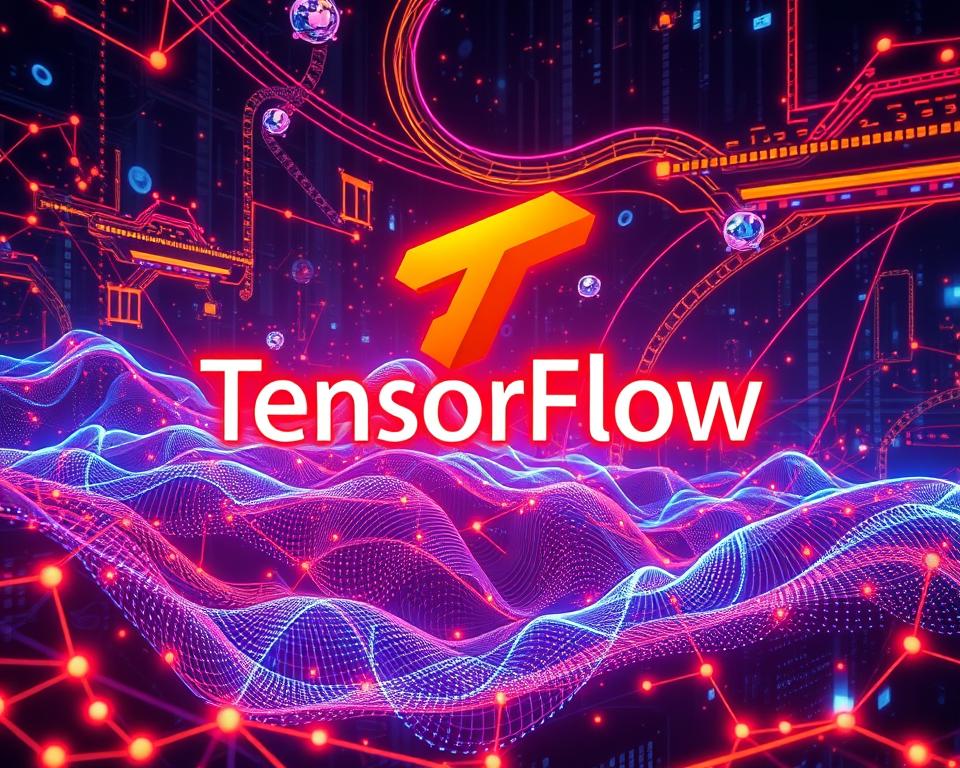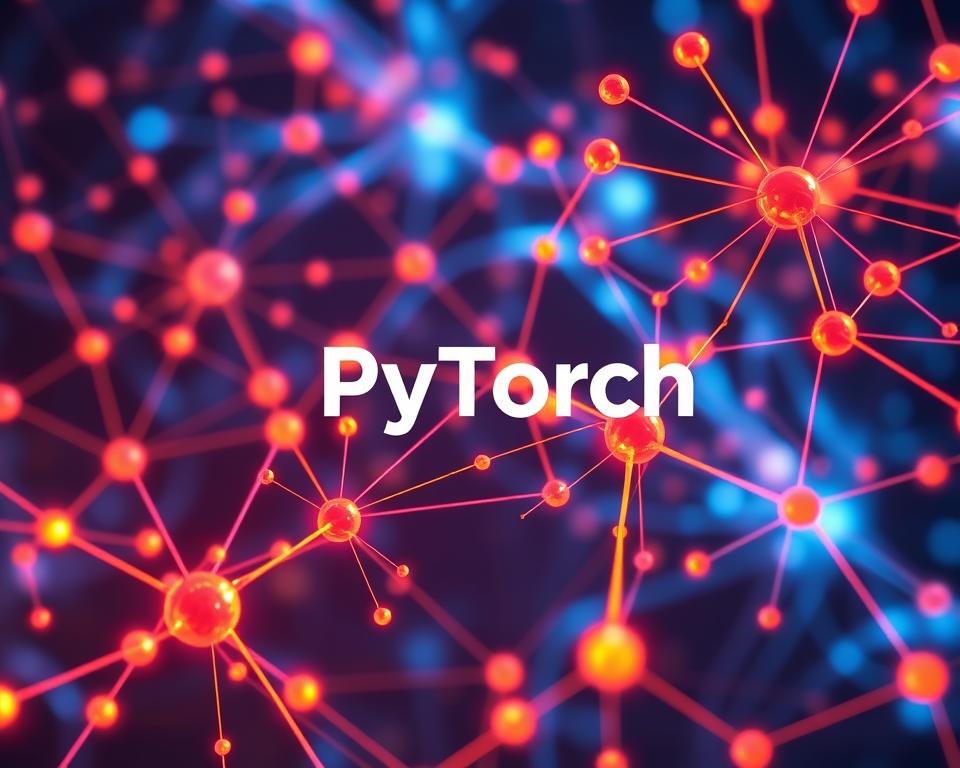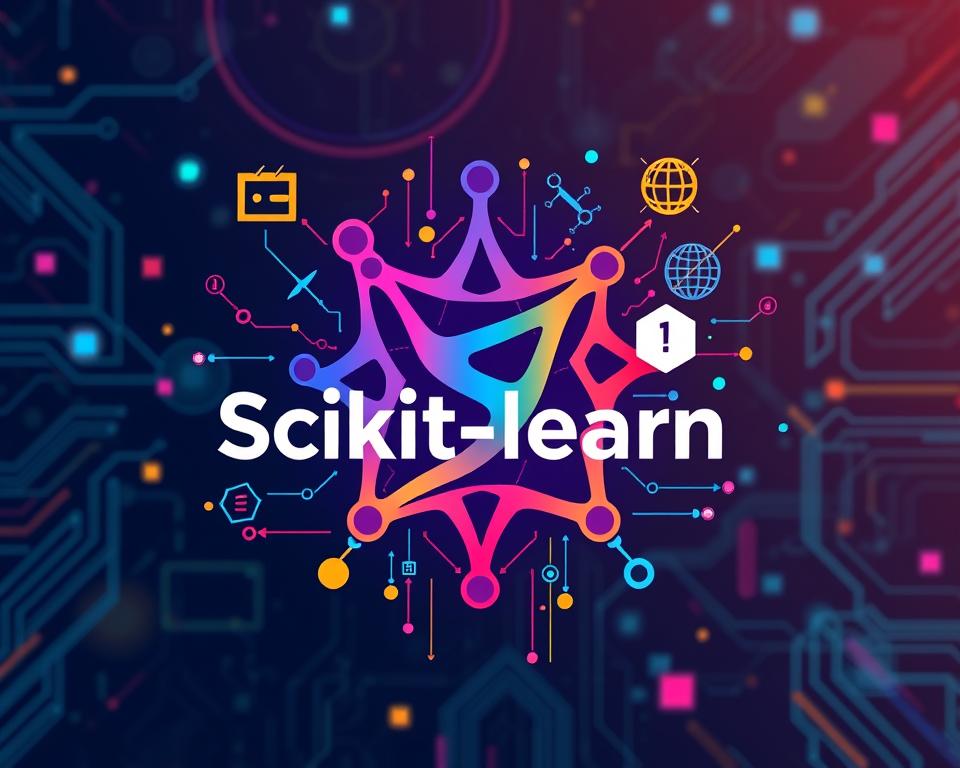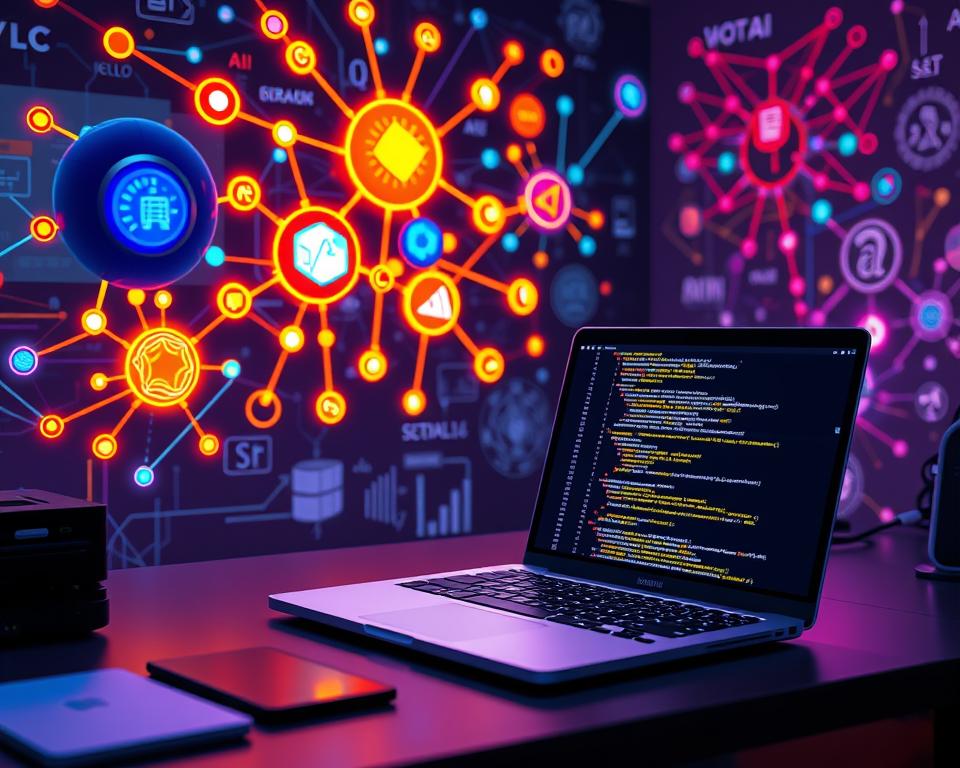In today’s fast-changing digital world, AI and ML are key for app making. They help developers build smart, flexible apps that meet user needs. As more apps need AI, knowing the best libraries is vital.
Table of Contents
Key Takeaways
- Explore the most prominent AI and ML libraries for app development.
- Understand the core concepts and benefits of integrating AI and ML into applications.
- Discover the essential requirements for successful AI library implementation.
- Gain insights into the features and capabilities of leading AI and ML frameworks.
- Learn how to choose the right library for your specific app development project.
This guide will cover the top AI and ML libraries. We’ll look at their features and how they improve apps. Knowing these technologies helps developers create engaging, smart apps.
Understanding AI and ML Libraries in Modern App Development
The digital world is changing fast. Artificial Intelligence (AI) and Machine Learning (ML) are key in app development now. They make apps work better and make making apps easier, leading to smarter and more user-friendly apps.
Core Concepts of AI Integration
AI apps can handle lots of data, finding patterns and trends. This helps them make better choices. By using AI, apps can learn and adapt, giving users what they need.
This makes apps easier to use and more in tune with what people want.
Benefits of ML Libraries in Applications
ML libraries bring many benefits to app development. They offer tools and algorithms that make apps smarter, saving time and money. They also let developers add cool features like predicting what users might want next.
This makes apps better and more efficient, improving how users feel about them.
Development Workflow Enhancement
Adding AI and ML to app development makes it faster and more efficient. These tools automate tasks, improve testing, and help make decisions based on data. This lets developers work on the important parts of their apps, making them better and faster to release.
As more apps use AI and ML, developers have a chance to make something truly special. They can create apps that are smart, user-friendly, and meet the latest digital needs.
Essential Requirements for AI Library Implementation
Adding AI libraries to your apps needs careful planning. You must look at the AI library prerequisites, hardware requirements, software dependencies, and the development environment.
First, knowing the AI library prerequisites is key. This includes the programming languages, API needs, and any special library needs. A team that knows these can avoid many problems.
Next, check the hardware requirements for AI apps. The type of models and data volume affect the needed hardware. CPU, GPU, and memory are crucial for app performance and growth.
| Hardware Component | Recommended Specification |
|---|---|
| Processor | Intel Core i7 or AMD Ryzen 7 |
| Graphics Processing Unit (GPU) | NVIDIA GeForce RTX 3080 or AMD Radeon RX 6800 XT |
| RAM | 16GB or more |
| Storage | 1TB SSD or higher |
Also, check the software dependencies and the development environment. Make sure the AI library works with your OS and other software. It should fit well with your app’s architecture.
Meeting these key needs helps developers use AI libraries well. This unlocks the power of these tools in app development.
TensorFlow: Google’s Powerhouse for Deep Learning
TensorFlow is a top name in deep learning. It was made by Google and is a leading open-source library for machine learning. It’s used for web apps and mobile development, loved by developers and researchers.
TensorFlow.js for Web Applications
TensorFlow shines in web environments. TensorFlow.js lets developers add deep learning to web apps. It makes apps more interactive and responsive.
This JavaScript library makes deploying models easy. It also supports real-time inference and updates. It’s a big deal for AI in web experiences.
Mobile Development with TensorFlow Lite
Google created TensorFlow Lite for mobile and embedded devices. It’s a slimmed-down version of TensorFlow. It lets developers run deep learning models on phones and tablets.
This opens up new possibilities for mobile apps. It uses TensorFlow, deep learning, and Google AI to power these apps.
Core TensorFlow Features
- Flexible and scalable architecture for building complex models
- Comprehensive set of high-level APIs for rapid model development
- Support for a wide range of hardware platforms, including GPUs and TPUs
- Seamless integration with other popular deep learning libraries like TensorFlow.js and TensorFlow Lite
- Robust training and deployment tools for optimizing model performance
TensorFlow is a top choice for deep learning. It has a big community and keeps getting better. It helps developers make amazing apps with Google AI and deep learning.
PyTorch: Facebook’s Dynamic Neural Networks
PyTorch, Facebook’s dynamic neural network library, is a powerful tool for AI and machine learning. It’s different from other deep learning frameworks because it lets users build and train neural networks in a more flexible way. This makes it great for experimenting and trying new things.
PyTorch’s core feature is its dynamic computational graph. This allows developers to change their models easily, without being stuck with a fixed structure. This flexibility is perfect for prototyping and research-focused projects, where quick changes and new ideas are key.
PyTorch also works well with the Facebook AI ecosystem. This means users can use the latest deep learning techniques from Facebook. This connection has made PyTorch a favorite among those working on dynamic neural networks and deep learning framework projects.
“PyTorch’s dynamic computational graph and intuitive API have made it a go-to choice for many AI researchers and developers. Its flexibility and ease of use have significantly accelerated the pace of innovation in the field of deep learning.”
As AI and machine learning keep growing, libraries like PyTorch will be key in creating new applications. They help push the limits of what’s possible with dynamic neural networks.
Scikit-learn: Machine Learning Simplified
In today’s app development, machine learning (ML) is key. Scikit-learn is a popular Python library for ML. It’s known for being simple and efficient.
Classification and Regression Tools
Scikit-learn has tools for classification and regression. It includes Support Vector Machines (SVMs), Random Forests, and Logistic Regression. These tools help developers solve many ML problems.
They can be used in many areas, making apps smarter and data-driven.
Data Preprocessing Capabilities
Scikit-learn is great at preparing data. It has tools for extracting features, reducing dimensions, and normalizing data. These are important for getting data ready for models.
Model Selection and Evaluation
Choosing and checking models is easier with Scikit-learn. It has tools like cross-validation and grid search. These help developers see how well their models work and improve them.
Using Scikit-learn makes adding ML to apps easier. Developers can focus on the app’s main features. This library is a top pick for teams wanting to add ML to their apps.
Top AI and Machine Learning Libraries for App Development
Artificial intelligence (AI) and machine learning (ML) are changing app development. Many powerful libraries have come out to help developers use these new technologies. These AI libraries and ML frameworks can do things like deep learning and natural language processing. They help make apps more smart, efficient, and user-friendly.
Some top AI libraries for app development are TensorFlow, PyTorch, Scikit-learn, and Keras. These tools let developers build, train, and use machine learning models. They help solve many problems in different fields, like image recognition and fraud detection.
| AI Library | Key Features | Suitable Applications |
|---|---|---|
| TensorFlow | Flexible, highly scalable deep learning framework | Computer vision, natural language processing, predictive analytics |
| PyTorch | Dynamic neural networks, GPU acceleration, rapid prototyping | Image recognition, natural language understanding, generative modeling |
| Scikit-learn | Comprehensive machine learning algorithms, data preprocessing tools | Predictive analytics, classification, regression |
| Keras | High-level neural networks API, easy model building and training | Deep learning applications, image and text processing |
Using these AI libraries and ML frameworks, developers can make smart software. This software meets the changing needs of users. As more apps need AI and ML, these libraries will be key in app development’s future.
Keras: High-Level Neural Networks API
Keras is a key player in AI and machine learning. It offers a user-friendly API for building neural networks. This framework is built on top of Keras and is favored by developers and data scientists.
Model Building and Training
Keras makes building complex neural networks easy. Its simple syntax and modular design let developers quickly define and connect layers. This makes it fast to prototype and test models.
Training models in Keras is also easy. It comes with many optimization algorithms and loss functions. Users can fine-tune their models efficiently. Keras also supports training on both CPU and GPU, speeding up large-scale training.
Integration with Other Frameworks
Keras stands out for its seamless integration with other frameworks. It works well with TensorFlow and Theano, among others. This flexibility lets developers pick the best tools for their projects.
“Keras is a high-level neural networks API, written in Python and capable of running on top of TensorFlow, CNTK, or Theano. It is designed to enable fast experimentation with deep neural networks and supports both convolutional networks and recurrent networks, as well as their combinations.”
Using Keras, developers can concentrate on the core of their deep learning models. This avoids the hassle of low-level details. Keras is a crucial tool for making AI development smoother, driving innovation and technology adoption.
Apache MXNet: Scalable Deep Learning
Apache MXNet is a top choice in the world of machine learning and deep learning. It’s designed for big projects and has special features for distributed training and multi-GPU support. This makes it perfect for ambitious developers and data scientists.
MXNet shines in handling distributed training. It uses many GPUs or machines to speed up training. This is key for tackling big deep learning tasks efficiently.
MXNet also excels in multi-GPU support. It uses many graphics processing units to train models faster. This leads to more accurate and quick applications, ideal for advanced deep learning projects.
MXNet does more than just scale and perform well. It also works great with cloud platforms. This makes it easy to deploy and scale deep learning models, streamlining the development process.
“Apache MXNet is a powerful and scalable deep learning framework that empowers developers to tackle large-scale machine learning projects with ease.”
Apache MXNet is great for many projects. Whether it’s an image recognition system, a natural language processing app, or a predictive analytics model, MXNet can help you achieve your goals.
NLTK: Natural Language Processing Tools
In the world of app development, the Natural Language Toolkit (NLTK) is a key player. It’s an open-source library for natural language processing (NLP). NLTK makes text analysis and language modeling easier, helping developers with natural language apps.
Text Processing Capabilities
NLTK is known for its strong text processing. It has tools for breaking down text, finding word roots, and identifying parts of speech. These tools help developers get insights from text data.
Whether you’re working on sentiment analysis, text classification, or machine translation, NLTK’s tools are helpful. They prepare and preprocess your data well.
Language Analysis Features
NLTK also has advanced language analysis tools. It includes named entity recognition, relationship extraction, and discourse analysis. These tools help developers understand language better.
NLTK’s language modeling is great for apps that need to understand context. This includes chatbots, virtual assistants, and decision support systems.
NLTK has detailed documentation and a big community of contributors. It’s a top choice for developers wanting to add natural language processing to their apps. By using NLTK, developers can improve user experience and drive innovation in app development.
OpenCV: Computer Vision Integration
In today’s app development, OpenCV stands out in computer vision. It’s an open-source library with tools and algorithms for image processing, object detection, and facial recognition. Developers can easily add these features to their apps.
OpenCV helps developers work with visual data efficiently. It has many pre-built algorithms for various tasks. From simple image edits to complex object tracking, it’s all possible.
OpenCV is very versatile. It works well with other AI and machine learning frameworks like TensorFlow and PyTorch. This makes apps more powerful and efficient.
| Feature | Description |
|---|---|
| Image Processing | OpenCV has tools for image manipulation, like color changes and feature extraction. |
| Object Detection | Its object detection algorithms help track objects in real-time. It’s great for surveillance and autonomous systems. |
| Facial Recognition | OpenCV’s facial recognition lets developers create apps that can identify people. This is useful for security and user authentication. |
OpenCV is a top choice for developers wanting to add computer vision to their apps. It offers powerful features and strong community support. With OpenCV, developers can create innovative solutions that change the digital world.
Fast.ai: Deep Learning Made Accessible
In the world of artificial intelligence and machine learning, Fast.ai is a standout. It makes deep learning easy for developers of all levels. Created by Jeremy Howard and Rachel Thomas, it simplifies AI. This lets users easily use practical AI applications, vision, and natural language processing (NLP).
Practical Deep Learning Applications
Fast.ai focuses on real-world uses of deep learning. It offers a structured course and easy tools. These help developers quickly make and use deep learning models for many tasks, like image recognition and NLP.
Fast.ai makes it easy to solve problems, not get lost in deep learning details.
Vision and NLP Solutions
Fast.ai excels in vision and NLP challenges. It has pre-built models and simple APIs. This makes adding advanced computer vision and NLP to apps easy.
Developers can now use advanced AI and machine learning without needing a lot of knowledge.
Fast.ai makes deep learning easy and accessible. It’s helping a new group of developers use AI to solve real problems. Its focus on practical use and easy tools is closing the gap between deep learning and software development needs.
Core ML: Apple’s Machine Learning Framework
In the fast-changing world of mobile app development, Core ML is a big deal. It’s Apple’s machine learning framework that changes the game for iOS developers. This tool lets developers add advanced AI and machine learning to their apps easily. It makes app development faster and gives users amazing experiences.
Core ML makes machine learning models work great on Apple devices. This means apps run smoothly and fast. Developers can use machine learning for mobile apps in many ways. This includes image recognition, natural language processing, and making apps more personal for users.
Core ML works well with the iOS system. Developers can add Core ML models to their apps easily. They use Apple’s Vision and Natural Language Processing APIs for more features. This makes app development easier and ensures apps work great on Apple AI devices.
| Feature | Description |
|---|---|
| Model Optimization | Core ML optimizes machine learning models for efficient performance on Apple devices, ensuring smooth integration and superior user experiences. |
| Vision API | Developers can leverage the Vision API for advanced computer vision tasks, such as image classification, object detection, and image segmentation. |
| Natural Language Processing | The Natural Language Processing API enables developers to integrate natural language processing capabilities, including text analysis, language translation, and sentiment analysis. |
By using Core ML, iOS development teams can make their apps truly special. They can create innovative and user-focused experiences. As more people want AI in their mobile apps, Core ML is a key tool for developers. It helps them explore new possibilities in mobile app development.
ML Kit: Google’s Mobile ML Solution
In the fast-changing world of mobile app development, Google’s ML Kit stands out. It’s a powerful tool for adding machine learning to your apps. This platform offers many features that can make your app better and more fun for users.
Face Detection and Recognition
ML Kit shines with its face detection and recognition. Developers can use it for many things, like:
- Facial authentication for better security
- Personalized photo tagging and organization
- Emotion analysis for more natural user interactions
With ML Kit, developers can add face detection and recognition to their Android and iOS apps. This opens up new ways to engage and innovate with users.
Text Recognition Features
ML Kit also excels in text recognition. It lets your app read and understand text from different places, like:
- Printed documents
- Business cards
- Handwritten notes
- Even real-time camera feeds
Thanks to on-device machine learning, ML Kit can recognize text very well. This makes it great for many apps, from digital assistants to document managers.
ML Kit shows Google’s dedication to making Google mobile AI available to app developers. It combines face detection, text recognition, and other advanced machine learning features. This helps developers make mobile experiences that are both innovative and focused on the user.
Choosing the Right Library for Your Project
Choosing the right library for AI and machine learning in app development is crucial. It depends on your project needs, goals, and the features you require. A good comparison of frameworks can help find the best library for you.
Look at performance, ease of use, community support, and the library’s success in your use cases. For deep learning tasks, TensorFlow or PyTorch might be best. For simpler models, Scikit-learn or Keras could work better.
| Library | Strengths | Suitable Use Cases |
|---|---|---|
| TensorFlow | Powerful deep learning, big community, and many deployment options | Complex neural networks, large AI projects, and big enterprise tasks |
| PyTorch | Dynamic graphs, great for research and quick prototyping | Advanced deep learning research, flexible model testing, and research projects |
| Scikit-learn | Wide machine learning toolkit, easy API, and strong data prep | Classic machine learning tasks like classification, regression, and clustering |
Evaluate your AI library selection, project requirements, and development goals carefully. This will help you choose the right library for success. The right library can make your AI app development easier and open new possibilities.
“The key to unlocking the full potential of AI in your app is finding the right library that aligns with your unique project needs and development goals.”
Performance Optimization and Best Practices
AI and machine learning are key in today’s app development. It’s vital to optimize these models’ performance. Developers need to focus on AI performance optimization, machine learning best practices, and model efficiency. This ensures the app runs smoothly and efficiently.
Model efficiency is a crucial aspect. Developers should aim to make their models simpler and smaller. This means using techniques like model pruning, quantization, and knowledge distillation. These methods help models work faster and use less resources.
- Use MLOps to automate model optimization. This keeps the models improving and adapting over time.
- Implement dynamic resource allocation. This lets the app adjust its resources as needed, based on demand and workload.
- Look into using hardware like GPUs or specialized AI chips. These can handle tough tasks, making the app more responsive.
| Optimization Technique | Description | Impact on Performance |
|---|---|---|
| Model Pruning | Removing unnecessary parts of a model. | Smaller model, faster processing, and less memory needed. |
| Model Quantization | Changing model parameters to use fewer bits. | Smaller model, quicker processing, and less work needed. |
| Knowledge Distillation | Training a smaller model to act like a larger one. | Less complex model, faster processing, and less resource use. |
By using these AI performance optimization and machine learning best practices, developers can make apps that are efficient and user-friendly. These apps will offer a great experience while also being well-managed and efficient.
“Optimizing AI and machine learning models is not just about improving performance – it’s about creating applications that are efficient, scalable, and responsive to user needs.”
Conclusion
The world of AI and machine learning libraries has changed how we make smart apps. Tools like Google’s TensorFlow and Facebook’s PyTorch help developers make new, exciting software. These tools let us do things we never thought possible.
The future of AI app development and machine learning trends looks very promising. These technologies are getting better and easier for everyone to use. Now, making smart software is a must in our fast-changing digital world.
Developers need to keep up with these new libraries and explore new ideas. By using AI and machine learning, we can make apps that are smarter and more personal. The future is full of endless possibilities, and we get to help shape it.



















